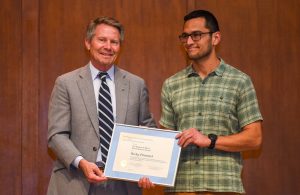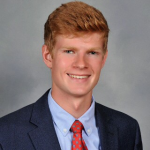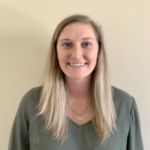The Applied Biomechanics Lab, along with an investigative team spanning principal investigators in the UNC College of Arts & Sciences, UNC School of Medicine, and NC State College of Engineering has received a $772k National Science Foundation Grant to revolutionize our region’s scientific and technological infrastructure for the quantitative measurement of human movement. With additional financial support from the Dean’s offices in the College of Arts & Sciences and the School of Medicine, the departments of Biomedical Engineering and Exercise and Sport Science, and the Office of the Vice Chancellor for Research, the grant will support not only the acquisition of a state-of-the-art high-speed biplane fluoroscopy system, but also technical support staffing, creation of a Collaborative Fluoroscopy Research Core, support for instructional innovation in the classroom, and development of new community outreach programs.
This was a plan that started in concept nearly three years ago and was a true team effort, especially the Principal Investigative team: Dr. Jason Franz (UNC/NC State BME), Dr. Brian Pietrosimone (UNC EXSS), Dr. Troy Blackburn (UNC EXSS), Dr. Kate Saul (NC State MAE), and Dr. Helen Huang (UNC/NC State BME). The proposal also received enthusiastic support from a broader network of scientists and engineers spanning UNC Greensboro, High Point University, NC A&T, and Elon University. This acquisition is the first such instrument available to any of the students, faculty, and fellows at the 17 public UNC system campuses, and its availability has the potential to catalyze lasting new disciplinary, collaborative, and interdisciplinary research and educational impact across our region.
High-speed biplane fluoroscopy systems provide continuous multi-dimensional cine x-ray images at up to 1000 samples/s for the purpose of directly quantifying three-dimensional bone positions, orientations, and articulating surface mechanics that are impossible to capture with even the most sophisticated of comparable technologies (e.g., MRI). The highly competitive award will allow a broad network for researchers, as well as the diverse student bodies they serve, to measure with unparalleled resolution the precise complexities of bone motion critical to overcoming the pivotal scientific and technological challenges across many disciplines, including: (1) understanding how musculoskeletal mechanics and function are achieved and maintained over the mammalian lifespan, (2) developing mechanistic links between movement biomechanics and underlying biology, (3) identifying technological opportunities for surgical innovation, (4) advancing ergonomics and occupational science toward for a strong and vibrant workforce, (5) developing more sophisticated bioengineered materials and tissues, and (6) introducing the next generation of rehabilitation robotics.
 We are very proud to congratulate Amanda Munsch for successfully defending her PhD dissertation, titled “Optimizing Knee Joint Loading: Association Between Quadriceps Contractile Behavior, Knee Joint Biomechanics, and Cartilage Contact Forces”. Outstanding job! We also thank the wonderful support of his committee members, Drs. Brian Pietrosimone (UNC EXSS), Mike Lewek (UNC PT), Brian Diekman (UNC/NSCU BME), and Josh Roth (UW-Madison ME). We will miss you, Mandy!!
We are very proud to congratulate Amanda Munsch for successfully defending her PhD dissertation, titled “Optimizing Knee Joint Loading: Association Between Quadriceps Contractile Behavior, Knee Joint Biomechanics, and Cartilage Contact Forces”. Outstanding job! We also thank the wonderful support of his committee members, Drs. Brian Pietrosimone (UNC EXSS), Mike Lewek (UNC PT), Brian Diekman (UNC/NSCU BME), and Josh Roth (UW-Madison ME). We will miss you, Mandy!!
 Ricky Pimentel, Doctoral Candidate in the Joint Department of Biomedical Engineering at UNC-Chapel Hill and NC State University, was recognized with the graduate student Bryan Award for outstanding community engagement and contributions through his work at the ReCyclery, and his leadership in cofounding Latinx in Biomechanix.
Ricky Pimentel, Doctoral Candidate in the Joint Department of Biomedical Engineering at UNC-Chapel Hill and NC State University, was recognized with the graduate student Bryan Award for outstanding community engagement and contributions through his work at the ReCyclery, and his leadership in cofounding Latinx in Biomechanix.

 Faster walking speeds increase the demand on quadriceps muscles to produce adequate force to decelerate body mass and control knee flexion. Quadriceps fascicle behavior (i.e., fascicle lengthen changes influences force generation, which in turn affects mechanical loading of the articular cartilage during walking and the biochemical environment of the knee joint. The fascicle behavior underlying different walking speeds remains unclear but should be characterized to better understand how the quadriceps muscles accommodate faster walking speeds, speeds that often associate with better cartilage health outcomes. Our purpose was to quantify quadriceps muscle net fascicle behavior during weight acceptance across a range of walking speeds in the context of more well-documented changes in muscle activity and knee joint moments. We hypothesized that vastus lateralis (VL) fascicles in healthy young adults would produce force with more overall lengthening in early stance at faster walking speeds with concomitant increases in muscle-tendon unit (MTU) lengthening, internal peak knee extensor moment (pKEM), vertical ground reaction force (GRF), and muscle activity. Participants walked for two-minute trials at their preferred speed and at 0.75 m/s and 1.75 m/s. We find that on average the VL accommodates the greater mechanical demands of walking at faster speeds with greater muscle activity and while resisting muscle lengthening behavior. We infer that tendon stretch accommodates MTU lengthening in healthy young adults across a range of speeds and suggest these results motivate additional studies aimed at evaluating VL fascicle behavior individuals with known quadriceps strength deficits, inhibition, or heightened risk for developing osteoarthritis.
Faster walking speeds increase the demand on quadriceps muscles to produce adequate force to decelerate body mass and control knee flexion. Quadriceps fascicle behavior (i.e., fascicle lengthen changes influences force generation, which in turn affects mechanical loading of the articular cartilage during walking and the biochemical environment of the knee joint. The fascicle behavior underlying different walking speeds remains unclear but should be characterized to better understand how the quadriceps muscles accommodate faster walking speeds, speeds that often associate with better cartilage health outcomes. Our purpose was to quantify quadriceps muscle net fascicle behavior during weight acceptance across a range of walking speeds in the context of more well-documented changes in muscle activity and knee joint moments. We hypothesized that vastus lateralis (VL) fascicles in healthy young adults would produce force with more overall lengthening in early stance at faster walking speeds with concomitant increases in muscle-tendon unit (MTU) lengthening, internal peak knee extensor moment (pKEM), vertical ground reaction force (GRF), and muscle activity. Participants walked for two-minute trials at their preferred speed and at 0.75 m/s and 1.75 m/s. We find that on average the VL accommodates the greater mechanical demands of walking at faster speeds with greater muscle activity and while resisting muscle lengthening behavior. We infer that tendon stretch accommodates MTU lengthening in healthy young adults across a range of speeds and suggest these results motivate additional studies aimed at evaluating VL fascicle behavior individuals with known quadriceps strength deficits, inhibition, or heightened risk for developing osteoarthritis.